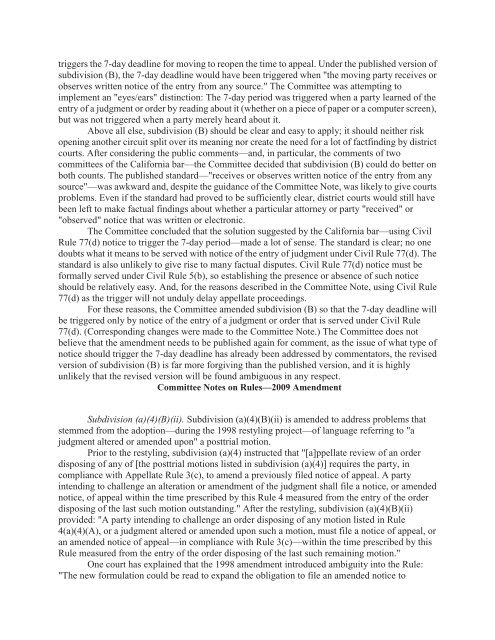Federal Rules of Appellate Procedure 2014-2015, 2014a
Federal Rules of Appellate Procedure 2014-2015, 2014a
Federal Rules of Appellate Procedure 2014-2015, 2014a
You also want an ePaper? Increase the reach of your titles
YUMPU automatically turns print PDFs into web optimized ePapers that Google loves.
triggers the 7-day deadline for moving to reopen the time to appeal. Under the published version <strong>of</strong><br />
subdivision (B), the 7-day deadline would have been triggered when "the moving party receives or<br />
observes written notice <strong>of</strong> the entry from any source." The Committee was attempting to<br />
implement an "eyes/ears" distinction: The 7-day period was triggered when a party learned <strong>of</strong> the<br />
entry <strong>of</strong> a judgment or order by reading about it (whether on a piece <strong>of</strong> paper or a computer screen),<br />
but was not triggered when a party merely heard about it.<br />
Above all else, subdivision (B) should be clear and easy to apply; it should neither risk<br />
opening another circuit split over its meaning nor create the need for a lot <strong>of</strong> factfinding by district<br />
courts. After considering the public comments—and, in particular, the comments <strong>of</strong> two<br />
committees <strong>of</strong> the California bar—the Committee decided that subdivision (B) could do better on<br />
both counts. The published standard—"receives or observes written notice <strong>of</strong> the entry from any<br />
source"—was awkward and, despite the guidance <strong>of</strong> the Committee Note, was likely to give courts<br />
problems. Even if the standard had proved to be sufficiently clear, district courts would still have<br />
been left to make factual findings about whether a particular attorney or party "received" or<br />
"observed" notice that was written or electronic.<br />
The Committee concluded that the solution suggested by the California bar—using Civil<br />
Rule 77(d) notice to trigger the 7-day period—made a lot <strong>of</strong> sense. The standard is clear; no one<br />
doubts what it means to be served with notice <strong>of</strong> the entry <strong>of</strong> judgment under Civil Rule 77(d). The<br />
standard is also unlikely to give rise to many factual disputes. Civil Rule 77(d) notice must be<br />
formally served under Civil Rule 5(b), so establishing the presence or absence <strong>of</strong> such notice<br />
should be relatively easy. And, for the reasons described in the Committee Note, using Civil Rule<br />
77(d) as the trigger will not unduly delay appellate proceedings.<br />
For these reasons, the Committee amended subdivision (B) so that the 7-day deadline will<br />
be triggered only by notice <strong>of</strong> the entry <strong>of</strong> a judgment or order that is served under Civil Rule<br />
77(d). (Corresponding changes were made to the Committee Note.) The Committee does not<br />
believe that the amendment needs to be published again for comment, as the issue <strong>of</strong> what type <strong>of</strong><br />
notice should trigger the 7-day deadline has already been addressed by commentators, the revised<br />
version <strong>of</strong> subdivision (B) is far more forgiving than the published version, and it is highly<br />
unlikely that the revised version will be found ambiguous in any respect.<br />
Committee Notes on <strong>Rules</strong>—2009 Amendment<br />
Subdivision (a)(4)(B)(ii). Subdivision (a)(4)(B)(ii) is amended to address problems that<br />
stemmed from the adoption—during the 1998 restyling project—<strong>of</strong> language referring to "a<br />
judgment altered or amended upon" a posttrial motion.<br />
Prior to the restyling, subdivision (a)(4) instructed that "[a]ppellate review <strong>of</strong> an order<br />
disposing <strong>of</strong> any <strong>of</strong> [the posttrial motions listed in subdivision (a)(4)] requires the party, in<br />
compliance with <strong>Appellate</strong> Rule 3(c), to amend a previously filed notice <strong>of</strong> appeal. A party<br />
intending to challenge an alteration or amendment <strong>of</strong> the judgment shall file a notice, or amended<br />
notice, <strong>of</strong> appeal within the time prescribed by this Rule 4 measured from the entry <strong>of</strong> the order<br />
disposing <strong>of</strong> the last such motion outstanding." After the restyling, subdivision (a)(4)(B)(ii)<br />
provided: "A party intending to challenge an order disposing <strong>of</strong> any motion listed in Rule<br />
4(a)(4)(A), or a judgment altered or amended upon such a motion, must file a notice <strong>of</strong> appeal, or<br />
an amended notice <strong>of</strong> appeal—in compliance with Rule 3(c)—within the time prescribed by this<br />
Rule measured from the entry <strong>of</strong> the order disposing <strong>of</strong> the last such remaining motion."<br />
One court has explained that the 1998 amendment introduced ambiguity into the Rule:<br />
"The new formulation could be read to expand the obligation to file an amended notice to


















